Cannabinoid inhibition of macrophage migration to the trans-activating (Tat) protein of HIV-1 is linked to the CB(2) cannabinoid receptor
- PMID: 20089805
- PMCID: PMC2846023
- DOI: 10.1124/jpet.109.163055
Cannabinoid inhibition of macrophage migration to the trans-activating (Tat) protein of HIV-1 is linked to the CB(2) cannabinoid receptor
Abstract
Macrophages and macrophage-like cells are important targets of HIV-1 infection at peripheral sites and in the central nervous system. After infection, these cells secrete a plethora of toxic factors, including the viral regulatory trans-activating protein (Tat). This protein is highly immunogenic and also serves as a potent chemoattractant for monocytes. In the present study, the exogenous cannabinoids delta-9-tetrahydrocannabinol (THC) and (-)-cis-3-[2-hydroxy-4-(1,1-dimethylheptyl)phenyl]-trans-4-(3-hydroxypropyl) cyclohexanol (CP55940) were shown to significantly inhibit migration of human U937 macrophage-like cells to the Tat protein in a concentration-related manner. The CB(1) receptor-selective agonist N-(2-chloroethyl)-5Z,8Z,11Z,14Z-eicosatetraenamide (ACEA) had no effect on Tat-mediated migration. In contrast, the CB(2) receptor-selective agonist (1R,3R)-1-[4-(1,1-dimethylheptyl)-2,6-dimethoxyphenyl]-3-methylcyclohexanol (O-2137) exerted a concentration-related inhibition of U937 cell migration in response to Tat. Pharmacological blockage of CB(1) receptor signaling using the antagonist 5-(4-chlorophenyl)-1-(2,4-dichlorophenyl)-4-methyl-N-(1-piperidyl)pyrazole-3-carboxamide hydrochloride (SR141716A) had no effect on CP55940-mediated inhibition of macrophage migration to Tat, whereas treatment with the CB(2) receptor antagonist (1S-endo)-5-(4-chloro-3-methylphenyl)-1-((4-methylphenyl)methyl)-N-(1,3,3-trimethylbicyclo(2.2.1)hept-2-yl)-1H-pyrazole-3-carboxamide (SR144528) reversed the CP55940-mediated inhibition of migration. In addition, THC had no inhibitory effect on U937 migration to Tat after small interfering RNA knockdown of the CB(2) receptor. Collectively, the pharmacological and biochemical knockdown data indicate that cannabinoid-mediated modulation of macrophage migration to the HIV-1 Tat protein is linked to the CB(2) cannabinoid receptor. Furthermore, these results suggest that the CB(2) cannabinoid receptor has potential to serve as a therapeutic target for ablation of HIV-1-associated untoward inflammatory response.
Figures
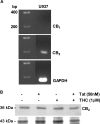


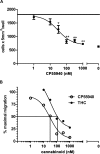
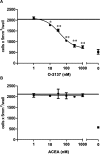
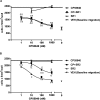
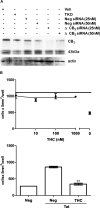
Similar articles
-
Cannabinoids inhibit migration of microglial-like cells to the HIV protein Tat.J Neuroimmune Pharmacol. 2011 Dec;6(4):566-77. doi: 10.1007/s11481-011-9291-6. Epub 2011 Jul 7. J Neuroimmune Pharmacol. 2011. PMID: 21735070
-
Characterization of cannabinoid agonists and apparent pA2 analysis of cannabinoid antagonists in rhesus monkeys discriminating Delta9-tetrahydrocannabinol.J Pharmacol Exp Ther. 2006 Dec;319(3):1211-8. doi: 10.1124/jpet.106.107110. Epub 2006 Aug 30. J Pharmacol Exp Ther. 2006. PMID: 16943255
-
Sex differences in cannabinoid 1 vs. cannabinoid 2 receptor-selective antagonism of antinociception produced by delta9-tetrahydrocannabinol and CP55,940 in the rat.J Pharmacol Exp Ther. 2012 Mar;340(3):787-800. doi: 10.1124/jpet.111.188540. Epub 2011 Dec 19. J Pharmacol Exp Ther. 2012. PMID: 22182934
-
Anandamide-mediated CB1/CB2 cannabinoid receptor--independent nitric oxide production in rabbit aortic endothelial cells.J Pharmacol Exp Ther. 2007 Jun;321(3):930-7. doi: 10.1124/jpet.106.117549. Epub 2007 Mar 22. J Pharmacol Exp Ther. 2007. PMID: 17379772
-
CB2 receptors in the brain: role in central immune function.Br J Pharmacol. 2008 Jan;153(2):240-51. doi: 10.1038/sj.bjp.0707584. Epub 2007 Nov 26. Br J Pharmacol. 2008. PMID: 18037916 Free PMC article. Review.
Cited by
-
CB2 receptor agonists protect human dopaminergic neurons against damage from HIV-1 gp120.PLoS One. 2013 Oct 17;8(10):e77577. doi: 10.1371/journal.pone.0077577. eCollection 2013. PLoS One. 2013. PMID: 24147028 Free PMC article.
-
Differential immune mechanism to HIV-1 Tat variants and its regulation by AEA [corrected].Sci Rep. 2015 May 6;5:9887. doi: 10.1038/srep09887. Sci Rep. 2015. PMID: 25943894 Free PMC article.
-
Peroxisomal and microsomal lipid pathways associated with resistance to hepatic steatosis and reduced pro-inflammatory state.J Biol Chem. 2010 Oct 1;285(40):31011-23. doi: 10.1074/jbc.M110.127159. Epub 2010 Jul 6. J Biol Chem. 2010. PMID: 20610391 Free PMC article.
-
Cannabinoid receptor-2 and HIV-associated neurocognitive disorders.J Neuroimmune Pharmacol. 2014 Sep;9(4):447-53. doi: 10.1007/s11481-014-9554-0. J Neuroimmune Pharmacol. 2014. PMID: 25015040
-
Differential migratory properties of monocytes isolated from human subjects naïve and non-naïve to Cannabis.Inflammopharmacology. 2013 Jun;21(3):253-9. doi: 10.1007/s10787-012-0133-9. Epub 2012 Apr 11. Inflammopharmacology. 2013. PMID: 22492174 Free PMC article.
References
-
- Albini A, Soldi R, Giunciuglio D, Giraudo E, Benelli R, Primo L, Noonan D, Salio M, Camussi G, Rockl W, et al. (1996) The angiogenesis induced by HIV-1 tat protein is mediated by the Flk-1/KDR receptor on vascular endothelial cells. Nat Med 2:1371–1375 - PubMed
-
- Bradford MM. (1976) A rapid and sensitive method for the quantitation of microgram quantities of protein utilizing the principle of protein-dye binding. Anal Biochem 72:248–254 - PubMed
-
- Cabral GA, Staab A. (2005) Effects on the immune system, in Handbook on Experimental Pharmacology: Cannabinoids (Pertwee R. ed) pp 385–423, Springer, Berlin: - PubMed
Publication types
MeSH terms
Substances
Grants and funding
LinkOut - more resources
Full Text Sources

